
Yogurt is a food produced by bacterial fermentation of milk. Fermentation of sugars in the milk by these bacteria produces lactic acid, which acts on milk protein to give yogurt its texture and characteristic tart flavor. Cow's milk is most commonly used to make yogurt. Milk from water buffalo, goats, ewes, mares, camels, and yaks is also used to produce yogurt. The milk used may be homogenized or not. It may be pasteurized or raw. Each type of milk produces substantially different results.
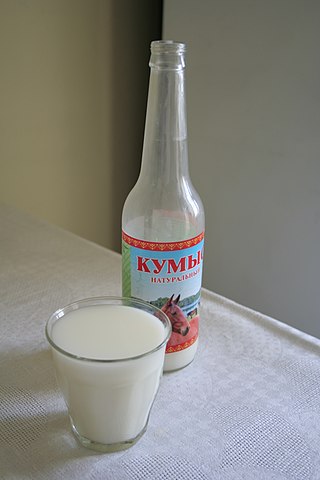
Kumis, alternatively spelled coumis or kumyz, also known as airag, is a traditional fermented dairy product made from mare milk. The drink is important to the peoples of the Central and East Asian steppes, of Turkic and Mongolic origin: Kazakhs, Bashkirs, Kalmyks, Kyrgyz, Mongols, and Yakuts. Kumis was historically consumed by the Khitans, Jurchens, Hungarians, and Han Chinese of North China as well.

Skyr is a traditional Icelandic cultured dairy product. It has the consistency of strained yogurt, but a milder flavor. Skyr can be classified as a fresh sour milk cheese, similar to curd cheese consumed like a yogurt in the Baltic states, the Low Countries and Germany. It has been a part of Icelandic cuisine for centuries.
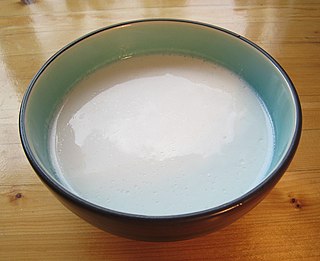
Plant milk is a category of non-dairy beverages made from a water-based plant extract for flavoring and aroma. Nut milk is a subcategory made from nuts. Plant-based milks are consumed as alternatives to dairy milk and provide similar qualities, such as a creamy mouthfeel, as well as a bland or palatable taste. Many are sweetened or flavored.

Ayran is a cold savory yogurt-based beverage that is consumed across Central Asia, and the Balkans. Ayran is also very popular in Turkey and Iran. The principal ingredients are yogurt, water and salt. Herbs such as mint may be optionally added. Some varieties are carbonated.

Kashk, qurut, chortan, or aaruul and khuruud is a range of dairy products popular in Iranian cuisine, Caucasian cuisine, and Central Asian cuisine. Kashk is made from strained yogurt, drained buttermilk or drained sour milk by shaping it and letting it dry. It can be made in a variety of forms, like rolled into balls, sliced into strips, and formed into chunks.
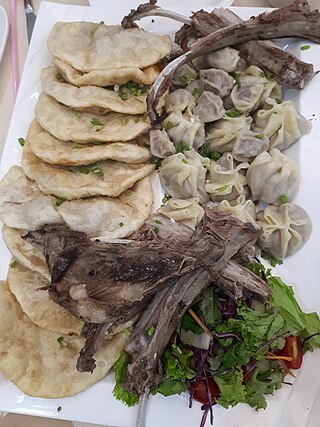
Mongolian cuisine predominantly consists of dairy products, meat, and animal fats. The most common rural dish is cooked mutton. In the city, steamed dumplings filled with meat—"buuz"— are popular.

In food processing, fermentation is the conversion of carbohydrates to alcohol or organic acids using microorganisms—yeasts or bacteria—without an oxidizing agent being used in the reaction. Fermentation usually implies that the action of microorganisms is desired. The science of fermentation is known as zymology or zymurgy.

Camel milk is milk from female camels. It has supported nomad and pastoral cultures since the domestication of camels millennia ago. Herders may for periods survive solely on the milk when taking the camels on long distances to graze in desert and arid environments, especially in parts of the Middle East, North Africa and the Horn of Africa. The camel dairy farming industry has grown in Australia and the United States, as an environmentally friendly alternative to cow dairy farming using a species well-adapted to arid regions.

Strained yogurt, Greek or Greek-style yogurt, yogurt cheese, sack yogurt, kerned yogurt or labneh is yogurt that has been strained to remove most of its whey, resulting in a thicker consistency than normal unstrained yogurt, while still preserving the distinctive sour taste of yogurt. Like many types, strained yogurt is often made from milk enriched by boiling off some water content, or by adding extra butterfat and powdered milk. In Europe and North America, it is often made from low-fat or fat-free cow's milk. In Iceland a similar product named skyr is made.

A smoothie is a beverage made by puréeing ingredients in a blender. A smoothie commonly has a liquid base, such as fruit juice or milk, yogurt or ice cream. Other ingredients may be added, including fruits, vegetables, non-dairy milk, crushed ice, whey powder or nutritional supplements.

Afghan cuisine is influenced by Persian, Central Asian, and South Asian cuisines due to Afghanistan's close proximity and cultural ties. The cuisine is halal and mainly based on mutton, beef, poultry and fish with rice and Afghan bread. Accompanying these are common vegetables and dairy products, such as milk, yogurt, whey, and fresh and dried fruits such as apples, apricots, grapes, bananas, oranges, plums, pomegranates, sweet melons, and raisins. The diet of most Afghans revolves around rice-based dishes, while various forms of naan are consumed with most meals. Tea is generally consumed daily in large quantities, and is a major part of hospitality. The culinary specialties reflect the nation's ethnic and geographic diversity. The national dish of Afghanistan is Kabuli palaw, a rice dish cooked with raisins, carrots, nuts, and lamb or beef.
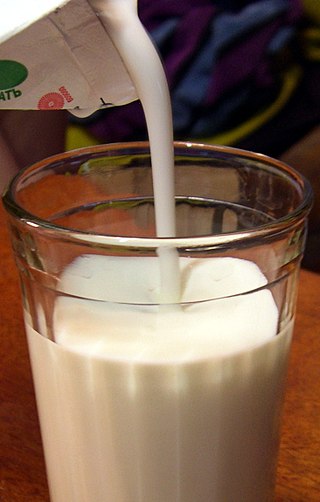
Kefir is a fermented milk drink similar to a thin yogurt or ayran that is made from kefir grains, a specific type of mesophilic symbiotic culture. It is prepared by inoculating the milk of cows, goats, or sheep with kefir grains.
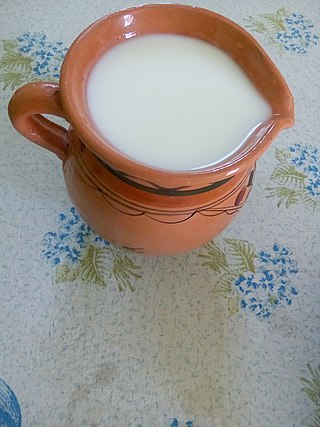
The term Leben, variously laban, liben, lben in the Middle East and North Africa, refers to a food or beverage of fermented milk. Generally, there are two main products known as leben: The yogurt variant for the Levant region and the buttermilk variant for parts of Arabia and North Africa (Maghreb). Leben can be served at breakfast, lunch, or dinner.

Middle Eastern cuisine or West Asian cuisine includes a number of cuisines from the Middle East. Common ingredients include olives and olive oil, pitas, honey, sesame seeds, dates, sumac, chickpeas, mint, rice and parsley, and popular dishes include kebabs, dolmas, falafel, baklava, yogurt, doner kebab, shawarma and mulukhiyah.
Carbonated milk or soda milk is a carbonated soft drink. It can be made from powdered milk or fresh milk, and often has added flavor. In addition to modified mouthfeel, carbonated milk also has a longer shelf-life than similarly processed flat milk and a different flavor. It is sold by several companies and is most popular in Asia.

Dahi or curd, also mosaru, dahi, thayir and perugu, is a traditional yogurt or fermented milk product originating from and popular throughout the Indian subcontinent. It is usually prepared from cows' milk, and sometimes buffalo milk or goat milk. The word curd is used in Indian English to refer to homemade yogurt, while the term yogurt refers to the pasteurized commercial variety known as "heat-treated fermented milk".
















